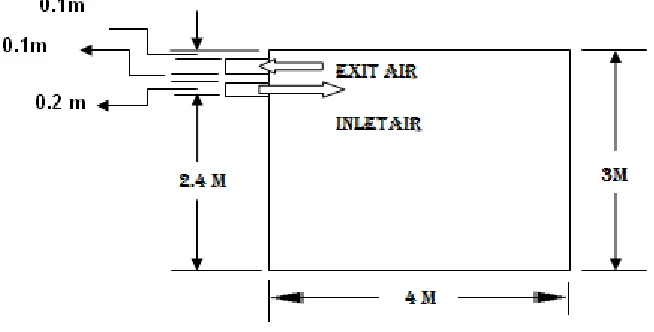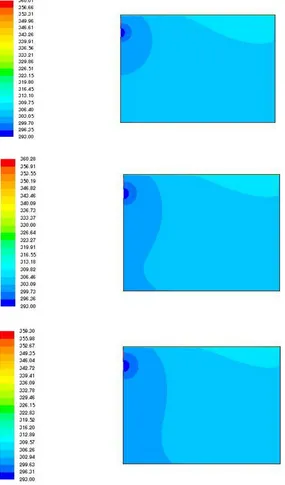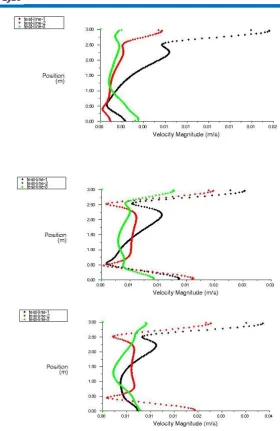Simulation of Effect of Changing supply air velocity on Indoor
Environment in Air Conditioning of Spaces
Shivani Sharma
1, Dr. V. N. Bartaria
21. M. E. Scholar, Department of Mechanical Engineering, LNCT, Bhopal 2. Professor and Head, Department of Mechanical Engineering, LNCT, Bhopal
Abstract: Air conditioning is the method
of conditioning of air as per the requirement of indoor environment. The indoor environment is characterised by the temperature along with velocity and other conditions of air. In a conditioned space it the objective of air conditioner to establish indoor environment which can provide comfort to the occupants of the conditioned space. Temperature and other conditions of human comfort are achieved in the conditioned space by proper distribution of conditioned air into the space. The supply air conditions and air distribution method both affect the indoor thermal environment. These also affect the energy consumption in refrigeration and power requirement in the blower. Engineers and designers are always interested in design and development of air conditioning system which consumes minimum power while providing comfort to its occupants. Researchers are working both in the development of efficient air conditioning methods as well as newer and efficient air distribution methods and optimised supply air conditions. In this paper effect of various supply air conditions for a typical air conditioning space has been numerically simulated to predict the optimum indoor thermal environment. The results show the optimum values of the temperature and velocity for the typical arrangement of air distribution.
Keywords: Temperature distribution, Numerical Simulation, Air conditioning
1. Introduction:
Air conditioning is the method of conditioning of air as per the requirement
of indoor environment. The indoor environment is characterised by the temperature along with velocity and other conditions of air. In a conditioned space it the objective of air conditioner to establish indoor environment which can provide comfort to the occupants of the conditioned space.
The air conditioner is essentially a system which removes the heat from the conditioned space with the help of refrigerant. This heat is taken by the supplied conditioned air at a particular temperature and velocity. When the cold conditioned air mixes with the indoor air its temperature and velocity changes. Due to the mixing of supplied air and the room air an indoor thermal environment is established. Temperature and other conditions of human comfort are achieved in the conditioned space by proper distribution of conditioned air into the space. The supply air conditions and air distribution method both affect the indoor thermal environment. These also affect the energy consumption in refrigeration and power requirement in the blower.
predict the optimum indoor thermal environment.
2. Numerical Analysis
To analyse a conditioned space, numerical and experimental investigations may be conducted. It is the objective of any investigation or research to get the desired outcome of the research with minimum cost of investigations. The cost is of two parts, one is related to money involved and other is time. In some cases one method of research investigation is suitable in a particular problem while other is not. Thus it should be the first step of research work to opt for the research method appropriate to the case with low cost of investigations. With this thought the authors have chosen the numerical method of investigation for the
simulation of indoor thermal
environment of a conditioned space supplied with conditioned air at variable
velocity while the temperature of air has been kept constant.
In this research work Computational Fluid Dynamics (CFD) method has been used to simulate the indoor thermal environment. This method is being used by the engineers and researchers most widely and of great choice of them because of its features of low cost of research. The results obtained by this method are acceptable with desired accuracies and desired form.
The figure 1 shows the arrangement of room with supply air position at a distance of 2.5 meters from the floor and return air location is at the height of 2.8 meters on the same wall. The dimensions of the room are typically taken as 4m Wide and 3 meter high as shown in figure 1.
Figure 1: Model of Room
3. Results
The computational domain is meshed with various densities of 34600, 40000 and 54000 cells. Negligible differences in solution are seen and for the complete results of solution the analysis is performed for the grid density of
and meshing. Solutions and post processing is done on FLUENT 6.3.26.
temperature is kept constant as 295K while the velocity is changed as 0.3 m/s, 0.4 m/s and 0.5 m/s respectively
Contours of temperature
Temperature contours for the three cases of supply air conditions are shown in figure 2. These have been obtained for three cases and are shown in figure 2 and. figure 3 respectively.
Figure 2: Temperature contours
Vertical Velocity Plots
Figure 3: Comparative velocity plots for three cases
Conclusion
In this paper effect of various supply air conditions for a typical air conditioning space has been numerically simulated to predict the optimum indoor thermal environment. The analysis is done using Computational Fluid Dynamics (CFD) method. The geometrical model was prepared in GAMBIT and for the set boundary conditions the problem was numerically solved in FLUENT to simulate the indoor environment. The Numerical results are obtained in the form of contours and plots. To show the indoor
values of velocity distribution at three test locations have also been shown. The optimum values of supply conditioned air are found as 295K temperature and 0.5m/s velocity. These values establish a uniform indoor thermal environment in the conditioned space.
References
[1] Somarathne, S., Kolokotroni, M., and Seymour, M., 2002, A single tool to assess the heat and airflows within an enclosure: preliminary test, ROOMVENT 2002, page 85-88.
the 3rd WSEAS Int. Conference on FINITE DIFFERENCES – FINITE ELEMENTS FINITE VOLUMES -BOUNDARY ELEMENTS, 2010,pp. 65-70. ISSN: 1790-2769, ISBN: 978-960-474-180-9.
[3] Jacobsen, T. S., Hansen, R., Mathiesen, E., Nielsen, P. V., and Topp, C., 2002, Design method and evaluation of thermal comfort for mixing and
displacement ventilation,
ROOMVENT 2002, page 209-212. [4] Q. Chen, K. Lee, K. Mazumdar, S.
Poussou, L. Wang, M. Wang and Z.
Zhang, Ventilation performance
prediction for buildings: Model
assessment,” Building and
Environment, 45(2), 2010, pp. 295-303.
[5]Kameel, R., and Khalil, E. E., 2002, Prediction of flow, turbulence, heat-transfer and air humidity patterns in
operating theatres, ROOMVENT
2002, page 69-72.
[6] Nielsen, 2011. Peter Vilhelm Nielsen. The "Family Tree" of Air Distribution Systems. Roomvent, 2011, 2011.
[7] Khalil, E. E., 2009, Thermal


